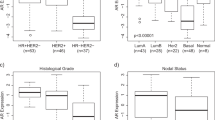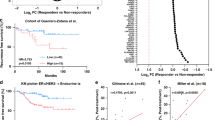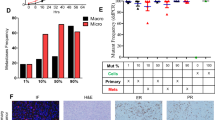Abstract
Little is known of the underlying biology of estrogen receptor-negative, progesterone receptor-negative (ER(−)/PR(−)) breast cancer (BC), and few targeted therapies are available. Clinical heterogeneity of ER(−)/PR(−) tumors suggests that molecular subsets exist. We performed genome-wide expression analysis of 99 primary BC samples and eight BC cell lines in an effort to reveal distinct subsets, provide insight into their biology and potentially identify new therapeutic targets. We identified a subset of ER(−)/PR(−) tumors with paradoxical expression of genes known to be either direct targets of ER, responsive to estrogen, or typically expressed in ER(+) BC. Differentially expressed genes included SPDEF, FOXA1, XBP1, CYB5, TFF3, NAT1, APOD, ALCAM and AR (P<0.001). A classification model based on the expression signature of this tumor class identified molecularly similar BCs in an independent human BC data set and among BC cell lines (MDA-MB-453). This cell line demonstrated a proliferative response to androgen in an androgen receptor-dependent and ER-independent manner. In addition, the androgen-induced transcriptional program of MDA-MB-453 significantly overlapped the molecular signature of the unique ER(−)/PR(−) subclass of human tumors. This subset of BCs, characterized by a hormonally regulated transcriptional program and response to androgen, suggests the potential for therapeutic strategies targeting the androgen signaling pathway.
This is a preview of subscription content, access via your institution
Access options
Subscribe to this journal
Receive 50 print issues and online access
$259.00 per year
only $5.18 per issue
Buy this article
- Purchase on Springer Link
- Instant access to full article PDF
Prices may be subject to local taxes which are calculated during checkout






Similar content being viewed by others
References
Agoff SN, Swanson PE, Linden H, Hawes SE, Lawton TJ . (2003). Am J Clin Pathol 120: 725–731.
Birrell SN, Bentel JM, Hickey TE, Ricciardelli C, Weger MA, Horsfall DJ et al. (1995). J Steroid Biochem Mol Biol 52: 459–467.
Buchanan G, Birrell SN, Peters AA, Bianco-Miotto T, Ramsay K, Cops EJ et al. (2005). Cancer Res 65: 8487–8496.
Carsol JL, Gingras S, Simard J . (2002). Mol Endocrinol 16: 1696–1710.
Cato AC, Nestl A, Mink S . (2002). Sci STKE 2002: RE9.
Cunliffe HE, Ringner M, Bilke S, Walker RL, Cheung JM, Chen Y et al. (2003). Cancer Res 63: 7158–7166.
de Hoon MJ, Imoto S, Nolan J, Miyano S . (2004). Bioinformatics 20: 1453–1454.
DeRisi J, Penland L, Brown PO, Bittner ML, Meltzer PS, Ray M et al. (1996). Nat Genet 14: 457–460.
Dhanasekaran SM, Dash A, Yu J, Maine IP, Laxman B, Tomlins SA et al. (2005). FASEB J 19: 243–245.
Dickson C, Spencer-Dene B, Dillon C, Fantl V . (2000). Breast Cancer Res 2: 191–196.
Farmer P, Bonnefoi H, Becette V, Tubiana-Hulin M, Fumoleau P, Larsimont D et al. (2005). Oncogene 24: 4660–4671.
Gatalica Z . (1997). Pathol Res Pract 193: 753–758.
Golub TR, Slonim DK, Tamayo P, Huard C, Gaasenbeek M, Mesirov JP et al. (1999). Science 286: 531–537.
Goss PE, Ingle JN, Martino S, Robert NJ, Muss HB, Piccart MJ et al. (2003). N Engl J Med 349: 1793–1802.
Greeve MA, Allan RK, Harvey JM, Bentel JM . (2004). J Mol Endocrinol 32: 793–810.
Gruber CJ, Tschugguel W, Schneeberger C, Huber JC . (2002). N Engl J Med 346: 340–352.
Gruvberger S, Ringner M, Chen Y, Panavally S, Saal LH, Borg A et al. (2001). Cancer Res 61: 5979–5984.
Hall RE, Aspinall JO, Horsfall DJ, Birrell SN, Bentel JM, Sutherland RL et al. (1996). Br J Cancer 74: 1175–1180.
Hall RE, Birrell SN, Tilley WD, Sutherland RL . (1994). Eur J Cancer 30A: 484–490.
Holzbeierlein J, Lal P, LaTulippe E, Smith A, Satagopan J, Zhang L et al. (2004). Am J Pathol 164: 217–227.
Howell A, Cuzick J, Baum M, Buzdar A, Dowsett M, Forbes JF et al. (2005). Lancet 365: 60–62.
Isola JJ . (1993). J Pathol 170: 31–35.
Jemal A, Murray T, Ward E, Samuels A, Tiwari RC, Ghafoor A et al. (2005). CA Cancer J Clin 55: 10–30.
Koziczak M, Hynes NE . (2004). J Biol Chem 279: 50004–50011.
Koziczak M, Holbro T, Hynes NE . (2004). Oncogene 23: 3501–3508.
Lacroix M, Leclercq G . (2004). Breast Cancer Res Treat 83: 249–289.
Laganiere J, Deblois G, Lefebvre C, Bataille AR, Robert F, Giguere V . (2005). Proc Natl Acad Sci USA 102: 11651–11656.
Lal P, Tan LK, Chen B . (2005). Am J Clin Pathol 123: 541–546.
Lippman M, Bolan G, Huff K . (1976). Cancer Res 36: 4610–4618.
Losel RM, Falkenstein E, Feuring M, Schultz A, Tillmann HC, Rossol-Haseroth K et al. (2003). Physiol Rev 83: 965–1016.
Matsuo K, Fukutomi T, Hasegawa T, Akashi-Tanaka S, Nanasawa T, Tsuda H . (2002). Breast Cancer 9: 43–49.
Mayfield S, Vaughn JP, Kute TE . (2001). Breast Cancer Res Treat 70: 123–129.
McKenna NJ, O’Malley BW . (2002). Endocrinology 143: 2461–2465.
Mellinghoff IK, Vivanco I, Kwon A, Tran C, Wongvipat J, Sawyers CL . (2004). Cancer Cell 6: 517–527.
Miller WR, Telford J, Dixon JM, Shivas AA . (1985). Breast Cancer Res Treat 5: 67–73.
Mosmann T . (1983). J Immunol Methods 65: 55–63.
Mouridsen H, Gershanovich M, Sun Y, Perez-Carrion R, Boni C, Monnier A et al. (2001). J Clin Oncol 19: 2596–2606.
Nagahata T, Onda M, Emi M, Nagai H, Tsumagari K, Fujimoto T et al. (2004). Cancer Sci 95: 218–225.
Nantermet PV, Masarachia P, Gentile MA, Pennypacker B, Xu J, Holder D et al. (2005). Endocrinology 146: 564–578.
Nelson PS, Clegg N, Arnold H, Ferguson C, Bonham M, White J et al. (2002). Proc Natl Acad Sci USA 99: 11890–11895.
Osborne CK, Wakeling A, Nicholson RI . (2004). Br J Cancer 90 (Suppl 1): S2–S6.
Perou CM, Sorlie T, Eisen MB, van de Rijn M, Jeffrey SS, Rees CA et al. (2000). Nature 406: 747–752.
Pusztai L, Ayers M, Stec J, Clark E, Hess K, Stivers D et al. (2003). Clin Cancer Res 9: 2406–2415.
Rossi S, Graner E, Febbo P, Weinstein L, Bhattacharya N, Onody T et al. (2003). Mol Cancer Res 1: 707–715.
Sapp M, Malik A, Hanna W . (2003). Breast J 9: 335–336.
Shao D, Lazar MA . (1999). J Clin Invest 103: 1617–1618.
Shurbaji MS, Kalbfleisch JH, Thurmond TS . (1996). Hum Pathol 27: 917–921.
Slamon DJ, Leyland-Jones B, Shak S, Fuchs H, Paton V, Bajamonde A et al. (2001). N Engl J Med 344: 783–792.
Smith IE, Dowsett M . (2003). N Engl J Med 348: 2431–2442.
Sorlie T, Tibshirani R, Parker J, Hastie T, Marron JS, Nobel A et al. (2003). Proc Natl Acad Sci USA 100: 8418–8423.
Steketee K, Ziel-van der Made AC, van der Korput HA, Houtsmuller AB, Trapman J . (2004). J Mol Endocrinol 33: 477–491.
Subramanian A, Tamayo P, Mootha VK, Mukherjee S, Ebert BL, Gillette MA et al. (2005). Proc Natl Acad Sci USA 102: 15545–15550.
Tang S, Han H, Bajic VB . (2004). Nucleic Acids Res 32: D533–D536.
Tobias JS . (2004). Ann Oncol 15: 1738–1747.
van’t Veer LJ, Dai H, van de Vijver MJ, He YD, Hart AA, Mao M et al. (2002). Nature 415: 530–536.
Wang Y, Klijn JG, Zhang Y, Sieuwerts AM, Look MP, Yang F et al. (2005). Lancet 365: 671–679.
West M, Blanchette C, Dressman H, Huang E, Ishida S, Spang R et al. (2001). Proc Natl Acad Sci USA 98: 11462–11467.
Wilson CA, Dering J . (2004). Breast Cancer Res 6: 192–200.
Wong YC, Xie B . (2001). Ital J Anat Embryol 106: 111–125.
Yakes FM, Chinratanalab W, Ritter CA, King W, Seelig S, Arteaga CL . (2002). Cancer Res 62: 4132–4141.
Acknowledgements
We thank Dr Dennis Watson for generously providing SPDEF antibody, Yixin Wang and John A Foekens for providing unpublished data, Adam Olshen and Gaorav Gupta for advice and manuscript review, Louis Vargus, Yonghong Xiao and Lishi Chen for technical assistance, Andea Aleodor for histological analysis and Faye Taylor for data management. We are indebted to the Pathology and Genomics Core Facilities at MSKCC for technical support. WG was supported by DAMD BC010104.
Author information
Authors and Affiliations
Corresponding author
Additional information
Supplementary Information accompanies the paper on Oncogene website (http://www.nature.com/onc).
Supplementary information
Rights and permissions
About this article
Cite this article
Doane, A., Danso, M., Lal, P. et al. An estrogen receptor-negative breast cancer subset characterized by a hormonally regulated transcriptional program and response to androgen. Oncogene 25, 3994–4008 (2006). https://doi.org/10.1038/sj.onc.1209415
Received:
Revised:
Accepted:
Published:
Issue Date:
DOI: https://doi.org/10.1038/sj.onc.1209415
Keywords
This article is cited by
-
Molecular targets and therapeutic strategies for triple-negative breast cancer
Molecular Biology Reports (2023)
-
Triple-negatives Mammakarzinom
Die Pathologie (2023)
-
Ceritinib is a novel triple negative breast cancer therapeutic agent
Molecular Cancer (2022)
-
Transcriptome profiling and proteomic validation reveals targets of the androgen receptor signaling in the BT-474 breast cancer cell line
Clinical Proteomics (2022)
-
Clinical-pathologic characteristics and response to neoadjuvant chemotherapy in triple-negative low Ki-67 proliferation (TNLP) breast cancers
npj Breast Cancer (2022)



